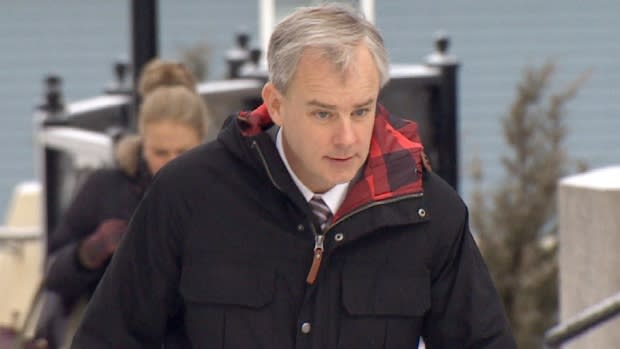Police treated Oland homicide scene 'like a tourist attraction,' defence alleges
The head of the Saint John Police Force's forensic identification section admits he could have done more to protect the Richard Oland homicide scene from possible contamination.
Sgt. Mark Smith made the statement Wednesday during the murder retrial of the victim's son, Dennis Oland.
Defence lawyer Michael Lacy suggested the bloody office where the multimillionaire's body was discovered on July 7, 2011, was "like a tourist attraction … in terms of the number of people coming in and out of there from law enforcement."
"There was a lot of people," replied Smith.
Most of the police officers were not wearing any protective gear, such as footwear coverings or latex gloves, the Court of Queen's Bench has heard.
Without special gear
Even Smith did not don any protective gear when he first entered the crime scene, even though he knew it was considered a "suspicious death."
He agreed under cross-examination that contaminated crime scenes can destroy important evidence and increase the chances of a wrongful conviction.
"In retrospect, could you have done more to protect the scene than you did?" Lacy asked.
"For sure," Smith said.
Oland, 50, is being retried for second-degree murder in the death of his father, who suffered 45 sharp- and blunt-force injuries.
He was the last known person to see the 69-year-old alive when he visited him at his investment firm office at 52 Canterbury St. on the evening of July 6, 2011.
A jury found Oland guilty in December 2015, but the New Brunswick Court of Appeal overturned his conviction and ordered a new trial, citing an error in the trial judge's instructions to the jury.
The retrial is scheduled to continue Thursday at 9:30 a.m. with the continued cross-examination of Smith.

Earlier in the trial, Smith testified he gave in to senior officers who "wished to view" the body before he had finished processing the scene.
On Wednesday, Lacy argued crime scene examiners are supposed to "make every effort" to ensure no one goes in while they're still processing the scene, "no matter how difficult it might be" and that "idle curiosity of police officers who want to come in and take a look around needs to be stopped."
Smith agreed he didn't follow all best practices in processing the crime scene.
"There are many things that you did that in retrospect you ought not to have done, correct?" the newest member of the defence team asked.
"Correct," replied Smith.
"There are many things you failed to do that in retrospect you ought to have done, correct?"
"Correct."
Lacy cited as an example Smith's "cursory" examination of the foyer outside the victim's second-floor office and the stairway down — one of only two possible exit routes for the "perpetrator or perpetrators."
He contrasted this with about 14 hours Smith spent inspecting and testing Oland's car for any evidence that might link him to the crime.
Possible bloody footwear impression
Lacy suggested Smith "completely missed" a possible footwear impression Richard Oland's killer might have left at the scene.
Earlier in the day, under questioning by lead Crown prosecutor P.J. Veniot, Smith testified he had noticed the "brownish, reddish" markings on the floor at some point on July 7, 2011, but he believed they had been created by himself and Const. Duane Squires when they removed the body.
It was only three years later, when comparing photos he took at the scene that morning with photos he took five days later, that he realized the geometric shapes "northeast of the victim's head" had been there before the body was removed, he said.
Smith pointed out the possible partial footwear impression in a photograph of the bloody crime scene displayed on a large screen in the courtroom.

In addition to numerous police officers, the court has heard two paramedics, the coroner and two funeral home employees also entered the crime scene.
Smith said he sent photographs of the tread-like patterns to the Shoeprint Image Capture and Retrieval database in Ottawa in March 2014, hoping to determine the make and model of the footwear that might have created them, but the results were negative.
He also took photographs and impressions of Squires's footwear, as well as six pairs of footwear seized from Oland's home on July 14, 2011, but he did not discuss the results in court.
He sent the photographs and impressions to an RCMP footwear expert for analysis, along with screenshots of video surveillance of Oland on July 6, 2011, before he went to visit his father, closeups of the shoes he was wearing, screenshots of his videotaped statement to police the day his father's body was discovered and closeups of his shoes, which Oland had identified to police as being the same ones he worn the night before.
Smith said he received a report back on April 28, 2014, but was not asked by Veniot about the findings.
Lacy suggested the defence may call the RCMP expert for its case.
